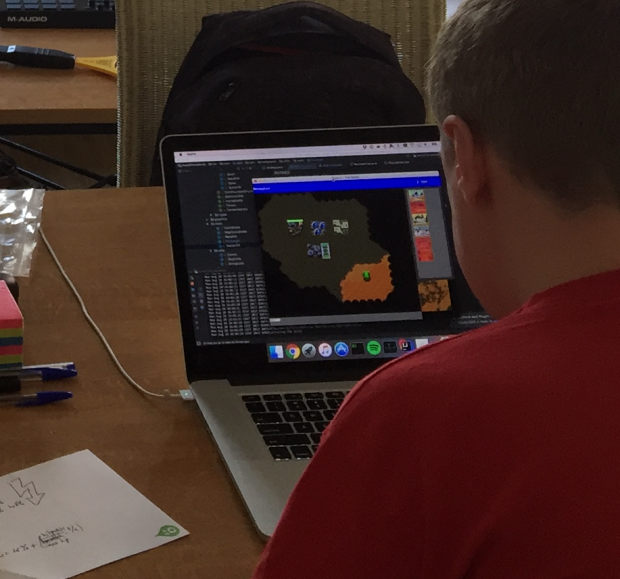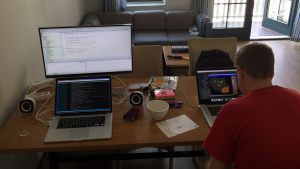Regardless of your language or framework – if you write a (web) app and read/write data to a SQL database (you manage), you’re bound to have changes on that database for whatever reasons.
Usually this is tackled by writing SQL migration scripts. For instance SQL files you can execute in your release procedure. You might pass these SQL files along with a ‘release document’ for a separate (OPS) department.
But what if we could automate this? Wouldn’t it be much nicer your application could detect which SQL files to execute, and then execute them? And when things break, it stops.
This blog post covers one of the many ways to do this. I start from a more general process and move to a more concrete Java implementation.
An automated deploy process
In this case I assume the following:
- You are not allowed to run any build process on your environment you deploy on. Ie there is no
mavenon yourprodenvironment (noracceptanceortest). - Up until now you execute
SQLmigrations manually. These areSQLsnippets you have and you use aSQLeditor (or command line) to execute them. - You want to automate these steps. (of course you do!)
So let’s make the hand by hand process a bit more formal:
- Write your own SQL script (You execute the bits you need, or you write it in such a way you can execute it fully all the time.)
- You stop your (web)app
- You open your SQL editor / prompt and execute your SQL script
- On failure, you roll back and reboot your app (and figure out what went wrong)
- On success you boot your (web)app
And what would an automated SQL migration process look like?
- It should use a
SQLfile that can be executed multiple times and have the same result (Ie the 2nd, or 3rd time should not result in other behaviour. Ie: Idempotent) - When your (web) app boots it should check if there are any
SQLfiles left to execute - The
SQLfiles are executed in a specific order (fromoldesttonewest) - It remembers which migrations have been executed
- Upon failure, stop executing migrations and stop booting
Notice the similarities!
Of course, you should have created a backup before doing any migration. Though that is out of scope of this post. It usually boils down to:
- create backup
- execute release procedure
- upon fail, report back. Put back backup, and boot old app.
- upon success, good for you!
Using ActiveJDBC’s DB Migrator
I have worked on a few projects using Ruby On Rails (abbreviated as RoR), which uses rake as build tool (kinda like maven). With that you could easily create new database migrations, execute migrations, etc. I was charmed by the simplicity.
In the land of Java, where I have used mostly Spring and Hibernate – I found ActiveJDBC (which is part of Javalite) which seems to be inspired by the approach RoR has taken.
Within ActiveJDBC there is also the usage of a migrator which reminds me of RoR’s rake db:migrate approach. It is a maven plugin and you call mvn db-migrator instead. It is very nice to create new migrations or run them.
Now the running part is the problem. While on your local machine you can run mvn db-migrator, I would not suggest to do that on my production (or any other) environment. So we need a way to run the migrator without the usage of maven.
Fortunately this is easy to fix.
Let’s get into some code.
Setting up ActiveJDBC in your Maven project
If you follow ActiveJDBC’s documentation it is easy to set up within your project. So I take that here, but expand upon it.
In your pom.xml you add the following as a plugin within the plugins section:
<!-- for creating db migrations with maven -->
<plugin>
<groupId>org.javalite</groupId>
<artifactId>db-migrator-maven-plugin</artifactId>
<version>${activejdbc.version}</version>
<configuration>
<migrationsPath>src/main/resources/sql/db-migrations</migrationsPath>
<environments>MY ENVIRONMENT</environments>
</configuration>
<dependencies>
<dependency>
<groupId>${jdbc.groupId}</groupId>
<artifactId>${jdbc.artifactId}</artifactId>
<version>${jdbc.version}</version>
</dependency>
</dependencies>
</plugin>
Where there are a few details:
jdbc.groupId, jdbc.artifactId and jdbc.version is your db connector. It could be mysql for instance. You probably have this dependency already defined in your project. So take that and put it there.
For activejdbc.version I use now 2.0.
One other thing to note is that I have deviated a bit from the default migrationsPath. In my case I put the sql files into src/main/resources/sql/db-migrations.
If you set this up, you can now create a migration. Test it by executing:
mvn db-migrator:new -Dname=<your name for your migration script>
The naming of migration scripts does not really matter – although it is good to have a structure in it. Usually I tend to write them as <action>_<type>_<name of column/table>_extra_info. Which results into something like: create_table_Books.
Suppose you took the last example as input:
mvn db-migrator:new -Dname=create_table_Books
It will result into:
/src/main/resources/sql/db-migrations/20180711170817_create_table_Books.sql
As you can see, a timestamp is prepended to the name you have given.
The timestamp is used by ActiveJDBC to determine if the SQL script should be executed or not. It basically keeps a record of the last time it executed any scripts. Then it would diff against the sql scripts it found. Any newer scripts are executed in the correct order (oldest to newest). In other words, do not touch the timestamp.
I’d suggest you play a bit with the plugin first, before going to the next step.
Executing the SQL Migrations from your (web) application
Now the real fun begins.
Include db-migrator as dependency in your project
So not as a plugin but also as a dependency. Like so:
<!-- DB Migrations -->
<!-- yes we use it as a plugin but also as a dependency! -->
<dependency>
<groupId>org.javalite</groupId>
<artifactId>db-migrator-maven-plugin</artifactId>
<version>${activejdbc.version}</version>
<exclusions>
<exclusion>
<groupId>org.sonatype.sisu</groupId>
<artifactId>sisu-guava</artifactId>
</exclusion>
</exclusions>
</dependency>
<!-- DB Migrations -->
**NOTE** I exclude the sisu-guava version because it is an older version than 20.0 and it will cause RuntimeExceptions when using Preconditions. Since I use version 25.x or newer in my own projects it clashes with the old version. So if you use Guava yourself and it is a newer version, make sure you exclude the old one like above.
Using it as a dependency makes it reachable for our code, while at the same time we can use the mvn db-migrator command alongside it.
Making sure your migrations run before your ORM is loaded
Usually web apps use an ORM (like Hibernate) and it requires the state of the DB to match the objects within the code. So your migrations (which alter state of the DB) should be executed before the ORM is booted.
So let’s start with that. You do this by adding a listener to your web.xml and place it at the top of all listeners. Making sure it is executed first. If you do not have any listeners, in my case they are positioned right after filters but before servlet definitions.
<!-- order is important, the database migrator must run before everything else --> <listener> <listener-class>com.fundynamic.webapp.listener.DatabaseMigratorListener</listener-class> </listener>
Now we have to make sure the class exists. Create the class, and let it implement ServletContextListener like so:
package com.fundynamic.webapp.listener;
import javax.servlet.ServletContextEvent;
import javax.servlet.ServletContextListener;
public class DatabaseMigratorListener implements ServletContextListener {
// Public constructor is required by servlet spec
public DatabaseMigratorListener() {
}
// -------------------------------------------------------
// ServletContextListener implementation
// -------------------------------------------------------
public void contextInitialized(ServletContextEvent sce) {
}
public void contextDestroyed(ServletContextEvent sce) {
/* This method is invoked when the Servlet Context
(the Web application) is undeployed or
Application Server shuts down.
*/
}
}
I’d suggest you put some System.out or logging there and see if it is executed in your application in the correct order before going to the next step.
Executing the migrations
Here we get into the meat of the problem.
Let’s start with the code
package com.fundynamic.webapp.listener;
import org.javalite.db_migrator.maven.MigrateMojo;
import org.slf4j.Logger;
import org.slf4j.LoggerFactory;
import javax.servlet.ServletContextEvent;
import javax.servlet.ServletContextListener;
public class DatabaseMigratorListener implements ServletContextListener {
private static final Logger log = LoggerFactory.getLogger(DatabaseMigratorListener.class);
// Public constructor is required by servlet spec
public DatabaseMigratorListener() {
}
// -------------------------------------------------------
// ServletContextListener implementation
// -------------------------------------------------------
public void contextInitialized(ServletContextEvent sce) {
String configFilePath = sce.getServletContext().getRealPath("/WEB-INF/classes/dbmigrator.properties");
String migrationsPath = sce.getServletContext().getRealPath("/WEB-INF/classes/sql/db-migrations");
try {
MigrateMojo mojo = new MigrateMojo();
mojo.setConfigFile(configFilePath);
mojo.setMigrationsPath(migrationsPath);
// we do not use environments like this, but we process the properties file in our build process with a maven profile
mojo.setEnvironments("myenv");
mojo.execute();
} catch (Exception e) {
log.error("Exception when executing migrator: ", e);
System.exit(-1); // stop further execution of the webapp with a non zero error code
}
}
public void contextDestroyed(ServletContextEvent sce) {
/* This method is invoked when the Servlet Context
(the Web application) is undeployed or
Application Server shuts down.
*/
}
}
Basically we do 2 things:
- We point to a
dbmigrator.propertieswhich provides properties for active-jdbc’s database migration properties - We set up the directory where to find the
SQL migration files(which is the same folder as we used in theplugin)
You can also see I set up an environment named myenv, in this case I use the same environment because I use maven profiles which interpolate environment specific variables for me. Another way would be to provide an environment variable so you can have 1 file but different property names.
Last but not least upon any exception we do a System.exit(1) to signify we should stop whatever we are doing.
Within the dbmigrations.properties file you will need at least credentials for the user which executes the migrations (I suggest you create a separate account for each environment for that), the file might look something like this:
myenv.driver=${jdbc.driverClassName}
myenv.username=${db.migrator.username}
myenv.password=${db.migrator.password}
myenv.url=${jdbc.url}
Here I also use serialized properties by maven, do note the variables all start with myenv which is the environment configured in the listener. The ${jdbc.driverClassName} and such are defined in my pom.xml.
Making execution optional
There are cases where you do not want to execute the migrations. For example you want to execute migrations automatically only on specific environments (ie, up till acceptance, but not yet on production). In that case
Add this in your web.xml
<!-- put this here somewhere on top of your web.xml file -->
<context-param>
<param-name>executeDatabaseMigrationsOnBoot</param-name>
<param-value>${db.migrator.execute}</param-value>
</context-param>
Again, the param-value is a serialized property. If you want to know more about those, see maven-war-plugin filtering options.
Either way you want to have the context-param so you can read out the value from your listener and do some logic with it.
I use a BoxingUtil class which is nothing but a simple helper method to make reading string to Boolean easier. The implementation of canParseBoolean is:
public static boolean canParseAsBoolean(String value) {
if (Boolean.TRUE.toString().equalsIgnoreCase(value) ||
Boolean.FALSE.toString().equalsIgnoreCase(value)) return true;
return false;
}
and parseBoolean is exactly what it does, but it make sure the value is not null. It is not of much importance here.
To read the property and do some logic it becomes like this:
String value = sce.getServletContext().getInitParameter("executeDatabaseMigrationsOnBoot");
if (!BoxingUtil.canParseAsBoolean(value)) {
log.error("Cannot parse value given for context-param (in web.xml) 'executeDatabaseMigrationsOnBoot', value is [" + value + "], but expected either [true] or [false]");
System.exit(-1); // stop further execution of the webapp with a non zero error code
}
boolean executeMigrations = BoxingUtil.parseBoolean(value);
now you can execute the rest of the listener code when this value is true.
The listener, complete code example
For completeness sake, here is the listener fully, with a bit of logging and with the flag to execute or not.
package com.fundynamic.webapp.listener;
import com.fundynamic.util.BoxingUtil;
import org.javalite.db_migrator.maven.MigrateMojo;
import org.slf4j.Logger;
import org.slf4j.LoggerFactory;
import javax.servlet.ServletContextEvent;
import javax.servlet.ServletContextListener;
public class DatabaseMigratorListener implements ServletContextListener {
private static final Logger log = LoggerFactory.getLogger(DatabaseMigratorListener.class);
// Public constructor is required by servlet spec
public DatabaseMigratorListener() {
}
// -------------------------------------------------------
// ServletContextListener implementation
// -------------------------------------------------------
public void contextInitialized(ServletContextEvent sce) {
log.info("--------------------------------------------------------------");
log.info("--------------------------------------------------------------");
log.info("--- DATABASE MIGRATOR STARTING --");
log.info("--------------------------------------------------------------");
log.info("--------------------------------------------------------------");
String value = sce.getServletContext().getInitParameter("executeDatabaseMigrationsOnBoot");
if (!BoxingUtil.canParseAsBoolean(value)) {
log.error("Cannot parse value given for context-param (in web.xml) 'executeDatabaseMigrationsOnBoot', value is [" + value + "], but expected either [true] or [false]");
System.exit(-1); // stop further execution of the webapp with a non zero error code
}
boolean executeMigrations = BoxingUtil.parseBoolean(value);
log.info("executeMigrations flag is [" + executeMigrations + "]");
if (executeMigrations) {
executeMigrations(sce);
} else {
log.info("Execute migrations was disabled, skipping executing migrations automatically!");
}
log.info("--------------------------------------------------------------");
log.info("--------------------------------------------------------------");
log.info("--- DATABASE MIGRATOR FINISHED --");
log.info("--------------------------------------------------------------");
log.info("--------------------------------------------------------------");
}
private void executeMigrations(ServletContextEvent sce) {
String configFilePath = sce.getServletContext().getRealPath("/WEB-INF/classes/dbmigrator.properties");
String migrationsPath = sce.getServletContext().getRealPath("/WEB-INF/classes/sql/db-migrations");
try {
MigrateMojo mojo = new MigrateMojo();
mojo.setConfigFile(configFilePath);
mojo.setMigrationsPath(migrationsPath);
// we do not use environments like this, but we process the properties file in our build process with a maven profile
mojo.setEnvironments("myenv");
mojo.execute();
} catch (Exception e) {
log.error("Exception when executing migrator: ", e);
System.exit(-1); // stop further execution of the webapp with a non zero error code
}
}
public void contextDestroyed(ServletContextEvent sce) {
/* This method is invoked when the Servlet Context
(the Web application) is undeployed or
Application Server shuts down.
*/
}
}
What if I want to rollback?
So there are 2 scenarios for this.
- you’re releasing, and something went wrong.
- your release went fine, but you want to revert some changes in the next release
In scenario #1 roll back to the backup you created before executing the release and migrations.
In scenario #2 your release went fine and you should create a new migration rolling back the changes. There is no reverting of SQL scripts. just a continuation. (roll-forward)
Conclusion
Automating your SQL migrations is pretty straight-forward. If you write idempotent SQL scripts and configure your (web) app to execute them automatically with ActiveJDBC’s db-migrator you get convenience for free. With this you are a step closer to automating your deploy process which is a very powerful tool for both developers and non-developers.
You can either use maven profile‘s or ActiveJDBC’s environments to differentiate properties. What you use is up to you.
If you found this helpful or have any questions, let me know.



